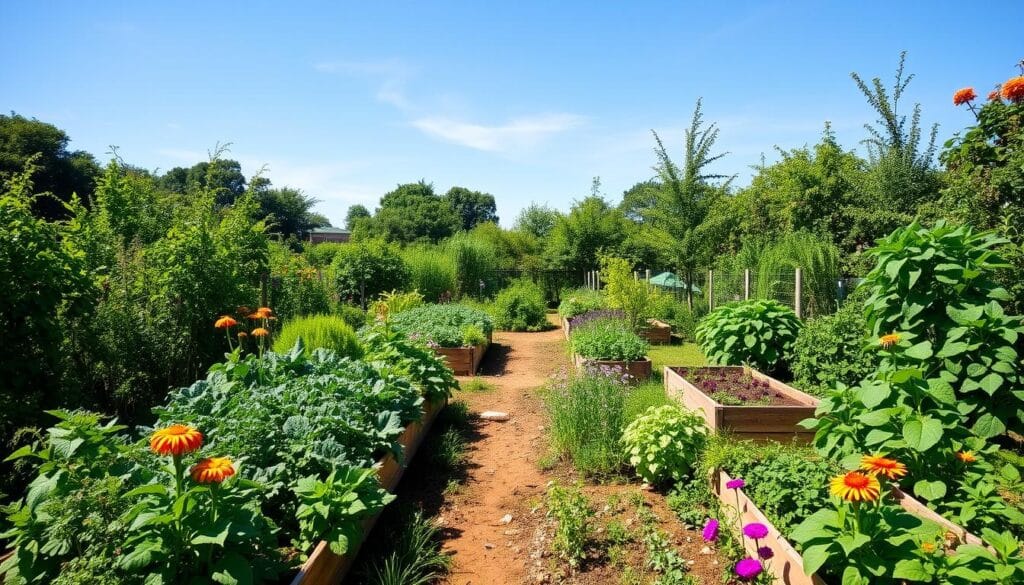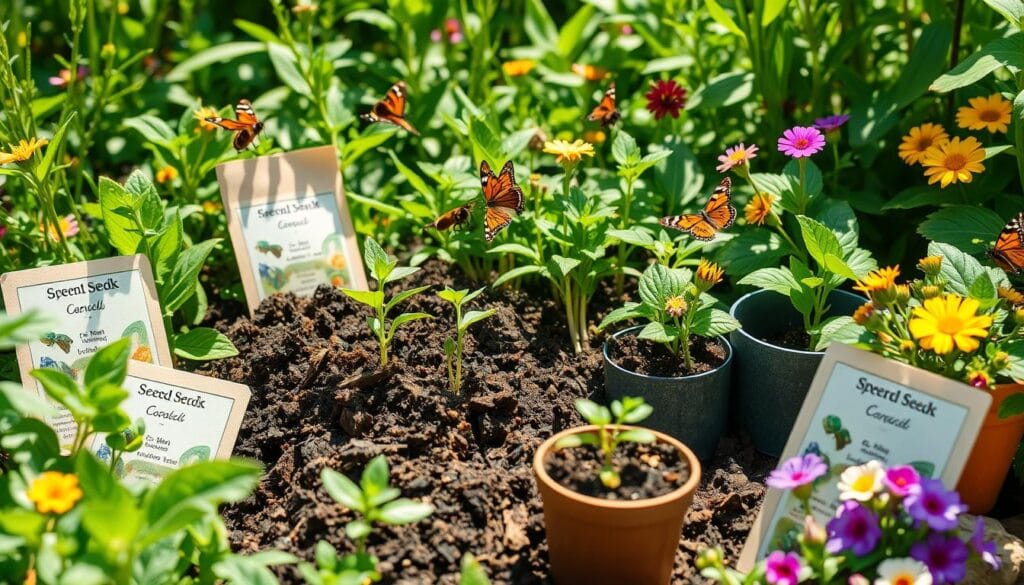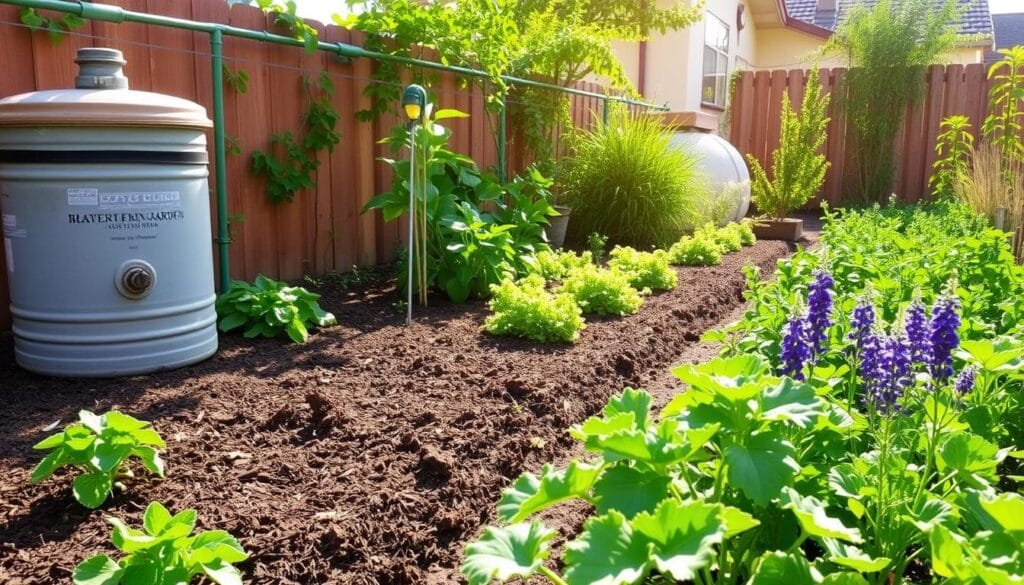Thinking about growing your own food? Sustainable vegetable gardening is a great choice. It’s perfect for those worried about pesticides and food quality. By gardening sustainably, you get fresh, chemical-free veggies and help the planet.
The Garden Continuum has been making outdoor spaces better since 1991. They can help you create an eco-friendly garden.
Imagine picking fresh veggies from your backyard for dinner. Sustainable gardening lets you do this. It also helps your garden stay healthy and balanced. Plus, it’s good for the environment and your wallet.
Key Takeaways
- You can reduce your carbon footprint by growing your own food through sustainable vegetable gardening.
- Organic gardening methods, such as companion planting and crop rotation, can help maintain a balanced and thriving garden.
- Sustainable vegetable gardening promotes a healthy ecosystem and connection with nature, family, and friends.
- Eco-friendly gardening practices, such as using natural pest control methods and mulching, can help reduce waste and minimize environmental impact.
- By following sustainable practices, you can enjoy fresh, chemical-free produce while contributing to a healthier environment.
What is Sustainable Vegetable Gardening?
Sustainable vegetable gardening is all about growing food that’s good for you and the planet. It uses natural ways to fight pests and diseases. It also saves water and cuts down on waste.
In cities, urban gardening is getting more popular. It lets people grow their own food, even in tiny spaces. This way, they get fresh food and help the environment by reducing transportation and packaging needs. By using permaculture ideas, city gardeners can make spaces that are full of life and waste less.
- Reduced environmental impact
- Improved soil health
- Increased crop yields
- Enhanced biodiversity
By gardening sustainably, you help the planet and enjoy fresh food from home. You don’t need a big space to start. Even a small balcony or backyard can be a place to grow food and make a difference.
Choosing the Right Location for Your Garden
Choosing the right spot for your vegetable garden is key to a great harvest. Your garden needs the right sunlight and soil. Most veggies need at least six hours of direct sunlight a day. Southern and western spots get the most sun, perfect for gardening.
Think about how much space you have and what veggies you want to grow. Start with easy ones like lettuce, spinach, radishes, and green beans. These are great for beginners and grow well in many conditions. Having your garden near water makes watering easier, and you can use soaker hoses to automate it.
Evaluating Sunlight and Soil Conditions
Soil mix is crucial for most plants. A mix of 40% sand, 40% silt, and 20% clay works well. But, some like broccoli and spinach can do okay in less sun and poorer soil. Also, think about nearby trees and buildings, as they can change sunlight and soil quality.
Accessibility and Convenience
Accessibility and convenience matter a lot when picking a garden spot. You should be able to get to your garden easily to care for it. Think about how far it is from your house and if there’s a good path. A well-chosen spot can make gardening more enjoyable and encourage you to garden more.
| Vegetable | Sunlight Requirements | Soil Conditions |
|---|---|---|
| Lettuce | 4-6 hours | Well-draining soil |
| Spinach | 4-6 hours | Moist soil |
| Radishes | 6 hours | Well-draining soil |
Planning Your Vegetable Garden Layout
Planning your vegetable garden layout involves several key factors. These include the soil type, sunlight, and available space. For sustainable food production, pick a spot that gets full sun, at least six to eight hours a day. It should also have well-draining soil with compost or manure added.
For organic gardening, consider using raised beds or containers. They’re great for rocky yards or soil that’s hard to till. Use garden design software or apps to plan your garden. This helps you fit the space and choose the right vegetables.
Some popular garden layouts include:
- Raised beds: quicker soil warming in the spring and ease of weeding and harvesting
- Container gardens: ideal for small spaces and can be moved to different locations
- Row gardens: suitable for larger spaces and can be used for a variety of vegetables
Remember to include paths for access. Think about using vertical gardens or four-square gardens to save space. Choose seedlings based on family likes, climate, and plant size. Avoid planting vegetables that stunt growth or attract pests and diseases.

By following these tips, you can create a thriving vegetable garden. It will support sustainable food production and organic gardening practices.
| Garden Layout | Space Required | Vegetable Options |
|---|---|---|
| Raised Bed | 4×4 feet | Tomatoes, peppers, cucumbers |
| Container Garden | 2×2 feet | Herbs, lettuce, radishes |
| Row Garden | 10×10 feet | Carrots, beans, zucchini |
Selecting Sustainable Seeds and Plants
Choosing the right seeds and plants is key for eco-friendly gardening. Look for varieties that grow well and are good for the environment. For urban gardens, pick compact plants that fit small spaces.
Start with easy-to-grow veggies like beans and root veggies. They need less water, which is better for the planet.
Heirloom seeds are a favorite for eco-friendly gardeners. They can be saved and reused, cutting down on waste. Hybrid seeds are bred for specific traits but might not be as sustainable. Opt for organic seeds to reduce waste even more.

Local nurseries are a great place to find sustainable seeds and plants. They use local producers, cutting down on packaging and transportation waste. They also offer advice on what plants will work best for your garden.
Supporting local nurseries helps the environment and the local economy. They promote eco-friendly gardening practices.
Tomatoes, melons, and squash are good choices for urban gardens. They have deep roots, so they need less water. Using a soil blocker made from materials like soup cans or PVC piping is another eco-friendly option.
| Seed Type | Benefits |
|---|---|
| Heirloom | Can be saved and reused, reducing waste |
| Hybrid | Bred for specific traits, such as disease resistance |
| Organic | Utilize 100% recyclable seed packets, reducing waste |
Soil Health and Enrichment
Starting your journey in sustainable food production means understanding soil health in permaculture. The health of your soil is key to a successful garden. By enriching your soil, you create a perfect environment for your plants to grow.
Soil is made up of topsoil, compost, and organic matter. Microneme organisms in the soil break down organic matter. They release nutrients and protect plants from pests and diseases. These microbes also help plants grow better and reduce soil erosion.
To keep your soil healthy, test its pH and adjust it with natural compost or manure. Most plants prefer a pH between 6.5 and 7.5. Adding compost can also help your soil hold more water, reducing the need for irrigation.
Using compost in your garden has many benefits. It improves soil structure and fertility. It also helps the soil hold more water and reduces erosion. Plus, it boosts plant growth and productivity.
- Improved soil structure and fertility
- Increased water-holding capacity
- Reduced soil erosion
- Improved plant growth and productivity
- Reduced plant stress during heat waves
By adding compost to your soil, you create a thriving ecosystem. This supports permaculture and sustainable food production. Every ton of compost can remove about 108 pounds of carbon dioxide from the atmosphere, helping fight climate change.

By focusing on soil health, you can make your garden fertile and productive. This supports your sustainable food goals and helps the environment.
| Soil Type | pH Range | Optimal Composition |
|---|---|---|
| Topsoil | 6.5-7.5 | Equal parts topsoil, compost, and sand |
| Raised Bed Soil | 6.5-7.5 | Mixture of topsoil, compost, and sand |
| Container Garden Soil | 6.5-7.5 | Lightweight potting mix with compost and sand |
Water Conservation Techniques
Starting your backyard vegetable garden? It’s key to use green gardening practices to save water. Saving water is very important, more so in dry areas. Using smart watering methods can cut down your water use a lot.
Drip irrigation systems are a top choice for saving water. They send water straight to the roots, cutting down on evaporation and runoff. Studies show drip irrigation can save up to 80% of water compared to regular watering.
Efficient Watering Practices
Water your plants in the morning or late afternoon for best results. This helps them soak up water and nutrients better, reducing loss. Also, mulch helps keep soil moist, cuts down on evaporation, and cools roots.
Rainwater Harvesting Systems
Collecting rainwater is another smart move. It lets you use less municipal water. This saved water is great for irrigation, cutting down on freshwater use.

Drip Irrigation vs. Traditional Methods
Drip irrigation beats traditional methods hands down. It delivers water right to the roots, saving water and preventing runoff. Plus, it’s often allowed during hose pipe bans, perfect for eco-friendly gardeners.
| Method | Water Usage | Efficiency |
|---|---|---|
| Drip Irrigation | 20% of traditional methods | 90% |
| Traditional Irrigation | 100% | 50% |
Using these water-saving tips, you can grow a lush vegetable garden. Always choose green gardening and smart watering to keep your garden healthy and the planet happy.
Pest Management the Natural Way
Starting your organic gardening journey means using eco-friendly methods. These practices help keep your garden balanced. Understanding pests’ life cycles helps you manage them without harming the environment.
Organic gardening balances plants, beneficial insects, and microorganisms. Companion planting is a key method. For example, marigolds with tomatoes repel nematodes, and basil keeps aphids away. Keeping your garden clean is also important for preventing pests.
Identifying Common Pests
Common pests include aphids, caterpillars, and snails. They can damage your plants. To manage them, use natural methods like diatomaceous earth, neem oil, and borax.
Organic Pest Control Methods
There are many organic ways to control pests. Mechanical and physical methods work fast without chemicals. Biological control uses beneficial organisms. Cultural controls, like crop rotation, also help.
By using these methods, you can keep your garden healthy. This reduces the need for harmful chemicals.
Seasonal Gardening Tips
Starting your sustainable food production journey means thinking about the seasons. Each season changes how you garden in the city. This way, you can grow lots of food and help the planet.
Think about what each plant needs. For example, lettuce and peas do well in cool spring. Tomatoes and peppers love the summer heat. Planting at different times helps you grow food all season.
- Put tall veggies on the north side to avoid shading smaller ones
- Plant different things a few weeks apart for a steady supply
- Pick plants that fit your local weather and space
By using these tips and adjusting to the seasons, you can make a great urban garden. It will give you fresh, healthy food all year.
Harvesting and Storing Your Produce
Starting your green gardening practices in your backyard vegetable gardening is exciting. Harvesting your fresh produce is a highlight. It’s important to pick your vegetables at the right time to keep them fresh.
Leafy greens can be picked as you need them. Root vegetables should be dug up when they’re big enough.
Some key things to remember when harvesting include:
- Harvest in the morning for longer freshness
- Harvest long-producing crops like beans often
- Vegetables like corn, cucumbers, and squash taste best when picked before they’re fully ripe
Storing your vegetables right is key to keeping them fresh. Keep them in a cool, dry spot. Every 10 F (-12 C) increase in storage temperature can shorten produce life by up to 25%.
Preserving your harvest through canning and freezing is a great way to enjoy your backyard vegetable gardening all year. Proper preservation lets you enjoy your fresh produce even when it’s not in season. With green gardening practices, you can harvest and store your own food, reducing waste and helping the environment.
| Vegetable | Harvesting Time | Storage Tips |
|---|---|---|
| Leafy Greens | As needed | Store in a cool, dry place |
| Root Vegetables | When mature | Store in a cool, dry place |
| Corn, Cucumbers, Squash | Before full maturity | Store in a cool, dry place |
Community Involvement and Support
Starting your journey? You’re not alone. Join a local club or start one with your neighbors. It’s a great way to get support, learn new things, and make friends.
Sharing tips and experiences can really help you grow. You’ll also help build a strong, eco-friendly community.
Also, don’t miss out on local farmers’ markets. They offer fresh, local produce and show respect for hardworking farmers. Supporting these farmers helps your local food system and the environment.
Remember, gardening is about more than just growing food. It’s about how you grow it and who you share it with. By working together, we can create a better future for everyone.
FAQ
What is sustainable vegetable gardening?
Sustainable vegetable gardening means growing your own food in an eco-friendly way. It helps reduce environmental harm, improves soil health, and gives you fresh, chemical-free food.
What are the benefits of sustainable vegetable gardening?
It’s good for the planet and for your health. You get to eat food without pesticides. It also fits with permaculture and supports growing food in cities.
How do I choose the right location for my vegetable garden?
Look at sunlight, soil, and how easy it is to get to. Think about how you can be kind to the environment. This helps you use your space well, whether it’s a big backyard or a small patio.
How do I plan the layout of my vegetable garden?
Choose between containers, in-ground, or raised beds. Use companion planting to help your garden grow better. Focus on growing food in a way that’s good for the planet.
What are the best sustainable seeds and plants to choose for my garden?
Pick heirloom or organic seeds from eco-friendly suppliers. Choose plants from local nurseries that garden sustainably.
How do I maintain soil health in my sustainable vegetable garden?
Test your soil and use compost and mulch. Rotate your crops to keep the soil healthy. These steps are key to a thriving garden.
What water conservation techniques can I implement in my vegetable garden?
Use water wisely, think about collecting rainwater, and use drip irrigation. These steps help save water and are good for the planet.
How can I manage pests naturally in my sustainable vegetable garden?
Know your pests and use natural ways to control them. Welcome beneficial insects. This keeps your garden healthy without harmful chemicals.
What are some seasonal gardening tips for sustainable vegetable growing?
Learn when to plant for your area, find ways to grow longer, and garden in winter. These tips help you grow food all year.
How can I properly harvest and store my sustainable garden produce?
Harvest your veggies right and store them well. This way, you can enjoy your garden’s bounty all year. It shows the value of gardening in a green way.
Source Links
- Grow Your Own: A Beginner’s Guide to Sustainable Vegetable Gardening at Home
- Starting a Garden From Scratch: Planting Food in Your Backyard
- A Guide to Organic Vegetable Farming: 10 Sustainable Practices and Benefits – HomeBiogas
- Sustainable Gardening: Solutions to Climate Change
- Vegetables Sustainable Agriculture – Penn State Extension
- What Is Sustainable Gardening?
- New Garden | gardeners.com
- Where Should You Put a Vegetable Garden?
- The Ultimate Guide to Picking a Location for Your Raised Bed Vegetable Garden
- We Share the Best Vegetable Garden Layouts to Try (Even Without Much Space)
- How to Plan Your Perfect Vegetable Garden
- How to Grow an Eco-Friendly Garden: Sustainable Seed Choices
- Sustainable Seed Starting Tips: 10 Easy, Eco-Friendly Ideas
- Nurturing Nature’s Best: Why Healthy Garden Soil is Essential for a Productive Vegetable Garden
- The Impact of Composting on Soil Health and Plant Growth
- Sustainable Gardening Using Water-Wise Methods — Plant Harmony
- Sustainable watering -conserve water in the Vegetable Garden
- Tips for Collecting Rainwater for Your Garden
- Organic Pest Control for the Garden
- How to Implement Sustainable Pest Management in Your Garden
- Vegetable Gardening for Beginners: The Complete Guide
- Tips for a Successful Summer Vegetable Garden – Dennis’ 7 Dees | Landscaping Services & Garden Centers
- Vegetable Gardening 101 – Gingham Gardens
- How And When To Harvest Vegetables For The Freshest Flavor Ever
- 6 Golden Rules For Harvesting Vegetables – Pick Perfect Produce Every Time
- When to Pick Your Vegetables – First Saturday Lime
- How Community Gardens Grow Happier, Healthier People and Stronger Neighborhoods
- Start or Participate In a Community Garden
- How to Grow a Chemical-Free Lawn: Eco-Friendly Lawn Care Tips
- Community Gardens: How US Cities Are Putting Them To Work –











Pingback: Natural Mulching Techniques for a Healthier, Greener Garden